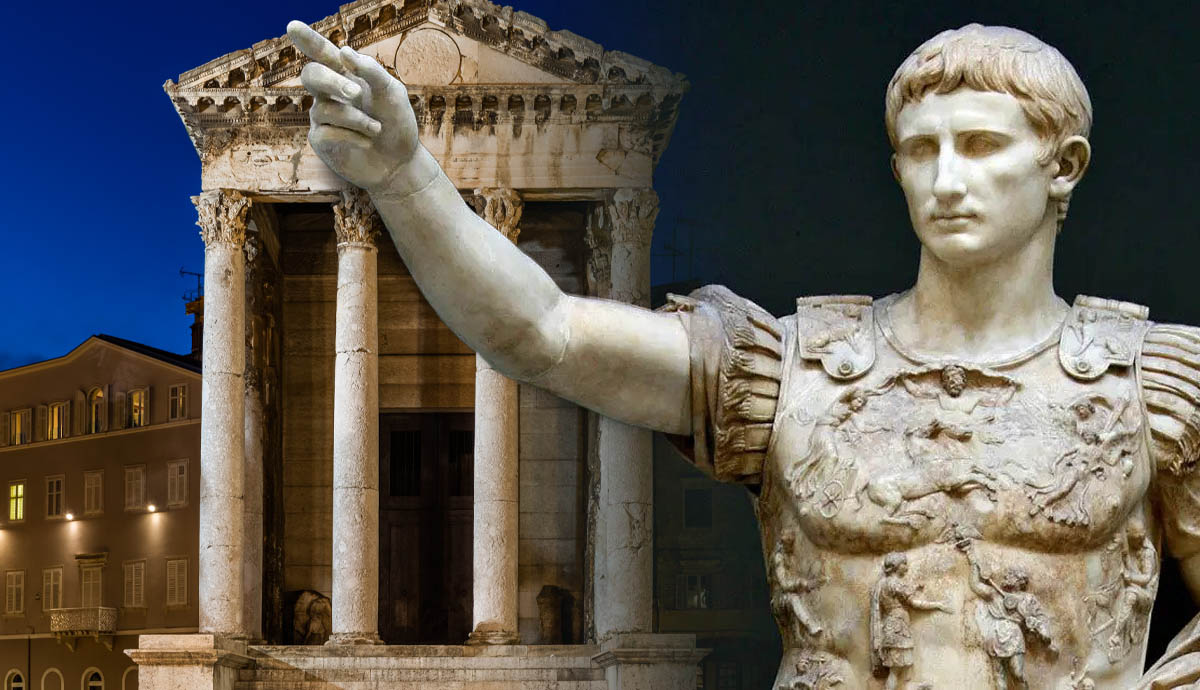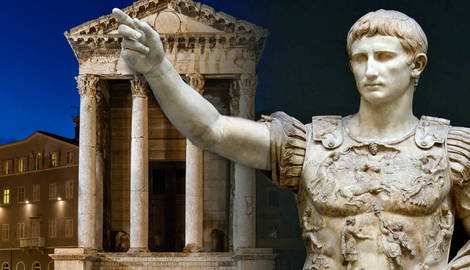
In its final century, the Roman Republic (c. 509-27 BCE) was beset by violent factionalism and chronic civil wars. The prolonged crisis culminated in 31 BCE, when Octavian led a fleet against Mark Antony and his Ptolemaic Egyptian ally and lover Cleopatra at Actium. Meanwhile, Roman territorial expansionism had transformed the Republic into an empire in all but name. The political system designed for a mere city-state was both undermined by dysfunction and completely overstretched. Rome was on the precipice of change and it was Augustus, the first Roman emperor, who from 27 BCE until his death in 14 CE, would oversee the end of the old Roman order and its transformation into the Roman Empire.
First Roman Emperor: Octavian Becomes Augustus

Following his victories, Octavian was well-positioned to assume responsibility for the stabilization of Rome and its empire. Octavian is better known as Augustus, but this name was adopted only once he acquired control over the Roman state. Yet despite the preceding chaos, Romans were still attached to their supposed political liberty and averse to monarchism.
Consequently, Octavian could not refer to himself as a supreme king or emperor, or even as a dictator in perpetuity, as Julius Caesar, his grand-uncle and adoptive father, had done with deadly consequences. Though, by the time he came to power, surely few people remembered how a stable Republic functioned. Hence, in 27 BCE when he adopted the Senate-approved titles Augustus and Princeps, he was able to assign the blood-stained associations of Octavian to the past and promote himself as the great restorer of peace.
“Augustus” generally translates as “the majestic/venerable one”, a worthy and grand epithet to celebrate his achievements. It evoked his authority without explicitly assuming his supremacy. “Princeps” translates as “first citizen”, which simultaneously placed him among and above his subjects, just as his being “primus inter pares”, first among equals, did. From 2 BCE, he was also given the title pater patriae, the father of the fatherland. Not once, however, did the first Roman emperor refer to himself as an emperor. He realized that names and titles carry weight, and ought to be navigated with due sensitivity.
Autocracy in the Republic’s Likeness

A brutal upheaval of Rome’s prior political order would surely have resulted in more turmoil. Keen to keep the Romans convinced that the Republic had not gone but was simply entering a new phase, Augustus was careful to maintain some general functioning of its practices, institutions, and terminology, even if power ultimately lay in his sole hands. So, in his speech upon entering his seventh consulship in 27 BCE, he claimed he was handing back power to the Senate and the Roman people, hence restoring the Republic. He even pointed out to the Senate, Cassius Dio wrote, that “it is in my power to rule over you for life”, but he would restore “absolutely everything” to prove he “desired no position of power”.
Rome’s now vast empire needed better organization. It was carved up into provinces, those on the fringes were vulnerable to foreign powers and governed directly by Augustus himself, the supreme commander of the Roman military. The safer remaining provinces were to be governed by the Senate and its selected governors (proconsuls).

The traditional magistracies that distributed power and state responsibilities were maintained, as were elections. Theoretically, nothing really changed, except that they became essentially an ineffective formality and Augustus assumed for himself a number of these powers for life.
For one, he held the consulship (the highest elected office) on 13 occasions, though he eventually realized this dominance did not favor the illusion of a Republican restoration. Therefore, he designed powers based on Republican offices such as the “power of a consul” or the “power of a tribune” without assuming the offices themselves. By the time he wrote his Res Gestae (a record of his deeds) in 14 CE, he was celebrating 37 years of tribunician power. With the power of the tribunes (the powerful office that represented the Roman plebeian class), he was granted sacrosanctity and could convene the Senate and people’s assemblies, conduct elections, and veto proposals while conveniently being immune to the veto himself.

Augustus also realized that he had to have the Senate, the bastion of aristocratic power, under his control. This meant both weeding out resistance and bestowing honors and respect. As early as 29 BCE, he removed 190 senators and reduced the membership from 900 to 600. Surely many of these senators were deemed threats.
Whereas before senatorial decrees were merely advisory, he now gave them the legal power that the people’s assemblies had once enjoyed. Now the people of Rome were no longer the main legislators, the Senate and the emperor were. Even so, in declaring himself “princeps senatus”, the first of the senators, he ensured his place at the top of the senatorial hierarchy. It was ultimately a tool in his personal administration. He controlled its membership and presided over it as an active participant, though he had the final say and the army and Praetorian Guard (his personal military unit) were at his disposal. The Senate in turn received Augustus well and endowed him with their approval, handing him the titles and powers that solidified his reign.
Image and Virtue

Yet political consolidation was not enough. Just as he portrayed himself as the savior of the Republic, Augustus went on a crusade against the perceived moral decay of Roman society.
In 22 BCE, he transferred to himself the lifelong powers of the censor, the magistrate responsible for overseeing public morality. With this authority, in 18-17 BCE he introduced a series of moral laws. Divorces were to be clamped down on. Adultery was criminalized. Marriage was to be encouraged but banned between different social classes. The allegedly low birth rate of the upper classes was to be disincentivized as unmarried men and women would face higher taxes.
Augustus targeted religion too, constructing several temples and reinstituting old festivals. His boldest move was 12 BCE when he declared himself the pontifex maximus, the chief high priest. From then on, it became a natural position of the Roman emperor and was no longer an elected office.
He also gradually introduced the imperial cult, though this was not imposed, merely encouraged. After all, Romans were likely to display discomfort at an idea so radically foreign to them, given their opposition to kingship alone. He even resisted an attempt by the Senate to declare him a living god. He would be declared a god only on his death, and he acted with divine authority as the “divi filius”, the son of the god Julius Caesar who was deified after his death.

Though there was some early receptivity. The Greeks of the eastern empire already had a precedent for king-worship. Soon enough, temples dedicated to the Roman emperor sprung up around the empire — as early as 29 BCE in the eastern city of Pergamon. Even in the more reluctant Latinized west, altars and temples appeared in his lifetime, in Spain from about 25 BCE and reaching a certain grandeur, as still seen in Pula, modern Croatia. Even in Rome, by 2 BCE Augustus’ reign was linked to the divine when he dedicated the Temple of Mars Ultor, which commemorated his victory at the Battle of Philippi in 42 BCE against Julius Caesar’s assassins. Augustus was cautious, not enforcing the imperial cult but stimulating the process to his own benefit. Piety to the emperor equaled safeguarding stability.
His propaganda machine also emphasized his humility. In Rome, Augustus apparently preferred to remain not in a grand palace, but in what Suetonius considered an unornate “small house”, though archaeological excavations have revealed what may have been a larger and more elaborate dwelling. And while he was supposedly frugal in his clothing, he wore shoes “a little higher than common, to make himself appear taller than he was”. Perhaps he was modest and somewhat self-conscious, but his tactic of reverse-conspicuous displays of consumption was palpable. Just as his shoes made him taller, his residence was placed atop the Palatine Hill, the preferred residential quarter of the Republican aristocracy overlooking the Forum and close to Roma Quadrata, the site believed to be Rome’s foundation. It was a balancing act between assertion over the Roman state and an outward exterior of modesty and equality.

The inauguration in 2 BCE of his own Forum Augustum to complement the congested older Forum Romanum, the historic heart of the Roman government, was more ostentatious. It was more spacious and monumental than its predecessor, adorned with a series of statues. They mostly commemorated famous Republican politicians and generals. However, the most prominent ones were those of Aeneas and Romulus, characters linked to the foundation of Rome, and that of Augustus himself, placed in the center on a triumphal chariot.
Implied in this artistic program, was not only the continuity of his reign from the Republican age, but its inevitability. Augustus was Rome’s destiny. This narrative was already established in Virgil’s Aeneid, the famous epic composed between 29 and 19 BCE which recounted Rome’s origins back to the legendary Trojan War and heralded the golden age Augustus was fated to bring. The Forum was a public space, so all inhabitants of the city could have witnessed and embraced this spectacle. If Augustus’ rule truly was destiny, it did away with the necessity of meaningful elections and honest Republican conventions.

Yet most “Romans” did not reside in Rome or anywhere near it. Augustus ensured that his image was known across the empire. It proliferated to an unprecedented extent, adorning public spaces and temples as statues and busts, and engraved on jewelry and the currency kept every day in people’s pockets and used at markets. Augustus’ image was known as far south as Meroë in Nubia (modern Sudan), where the Kushites had buried a striking bronze bust looted from Egypt in 24 BCE beneath a stairway leading to an altar of victory, to be trampled on by the feet of its captors.
His image remained consistent, forever trapped in his handsome youth, quite unlike the brutal realism of earlier Roman portraits and Suetonius’ less savory physical description. It is possible that standard models were sent out from Rome across the provinces to disperse the emperor’s idealized image.
Augustus the Chameleon

Perhaps the most symbolic act of Augustus’ consolidation as the first Roman emperor was the renaming by the Senate of the sixth month Sextilis (the Roman calendar had ten months) as August, just as Quintilis, the fifth month, had been renamed July after Julius Caesar. It was as though he became an inherent part of the natural order of time.
Augustus went virtually unchallenged not only because the Romans were exhausted from the upheavals of the late Republic, but because he managed to convince them that he was safeguarding the political liberties they cherished. Indeed, he introduced his Res Gestae, the monumental description of his life and accomplishments which was disseminated across the empire, by stating, “he subjected the whole wide earth to the rule of the Roman people”. Augustus’ strategy was to fabricate an illusion of popular power that made the new autocratic state more palatable. Moreover, he was no longer a faceless or impersonal ruler to millions. His intrusion into the more intimate elements of people’s lives made his values, character, and image inescapable.
The later fourth century CE emperor Julian quite aptly referred to him as a “chameleon”. He attained a balance between effective monarchy and a cult of personality on the one hand, and an ostensible continuity of Republican convention on the other which allowed him to transform Rome forever. He found Rome a city of bricks but left it a city of marble, or so he famously boasted. But even more than physically, he completely altered the course of Roman history, knowingly ending the Republic without ever announcing it.










